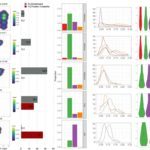Link to Pubmed [PMID] – 31378263
Tuberculosis (Edinb) 2019 Jul;117:18-23
Tuberculosis (TB) is the most deadly infectious disease worldwide. To reduce TB incidence and counter the spread of multidrug resistant TB, the discovery and characterization of new drugs is essential. In this study, the transcriptional response of two Mycobacterium tuberculosis strains to a pressure of the recently approved delamanid is investigated. Total RNA sequencing revealed that the response to this bicyclic nitroimidazole shows many similarities with pretomanid, an anti-tuberculous drug from the same class. Although delamanid is found to inhibit cell wall synthesis, the expression of genes involved in this process were only mildly affected. In contrast, a clear parallel was found with components that affect aerobic respiration. This demonstrates that, besides the inhibition of cell wall synthesis, respiratory poisoning plays a fundamental role in the bactericidal effect of delamanid. Remarkably, the most highly induced genes comprise poorly characterized genes for which functional characterization might hint to the target molecule(s) of delamanid and its exact mode(s) of action.






